Лексикология - lecture 2.pptx
- Количество слайдов: 36
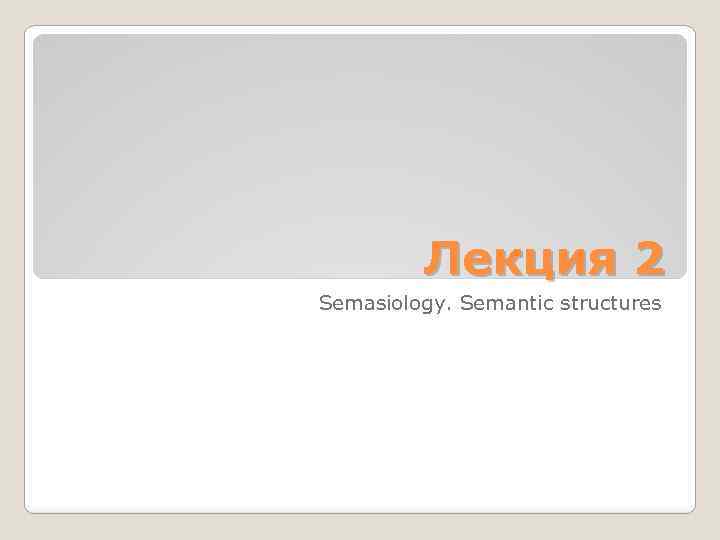 Лекция 2 Semasiology. Semantic structures
Лекция 2 Semasiology. Semantic structures
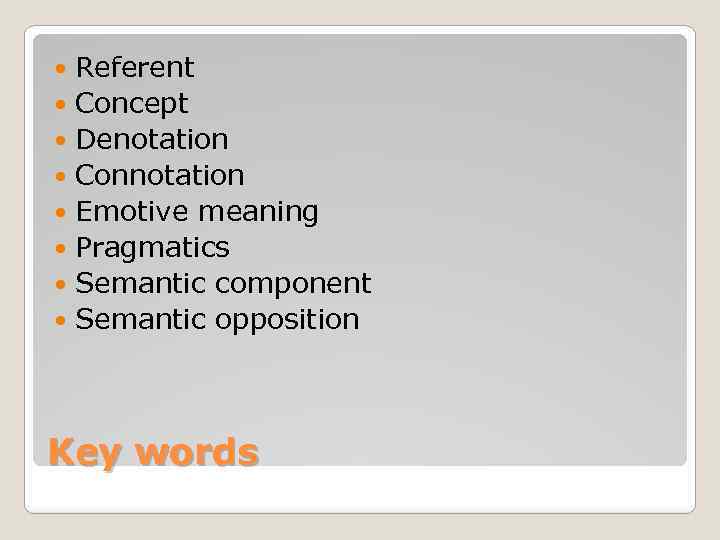 Referent Concept Denotation Connotation Emotive meaning Pragmatics Semantic component Semantic opposition Key words
Referent Concept Denotation Connotation Emotive meaning Pragmatics Semantic component Semantic opposition Key words
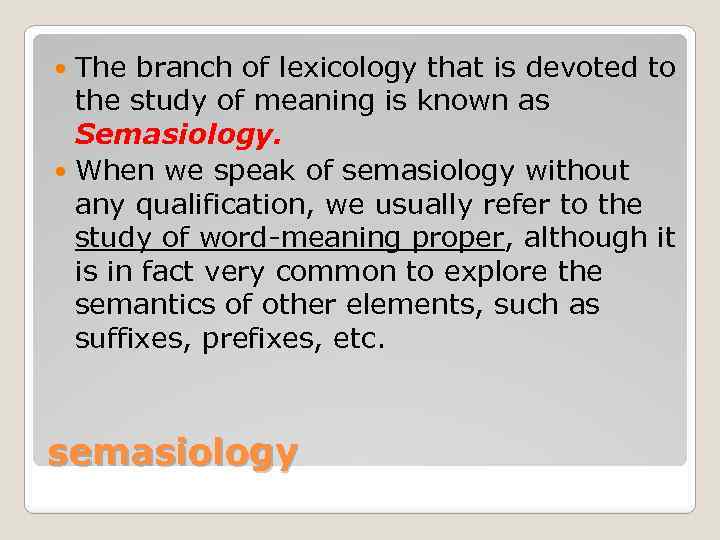 The branch of lexicology that is devoted to the study of meaning is known as Semasiology. When we speak of semasiology without any qualification, we usually refer to the study of word-meaning proper, although it is in fact very common to explore the semantics of other elements, such as suffixes, prefixes, etc. semasiology
The branch of lexicology that is devoted to the study of meaning is known as Semasiology. When we speak of semasiology without any qualification, we usually refer to the study of word-meaning proper, although it is in fact very common to explore the semantics of other elements, such as suffixes, prefixes, etc. semasiology
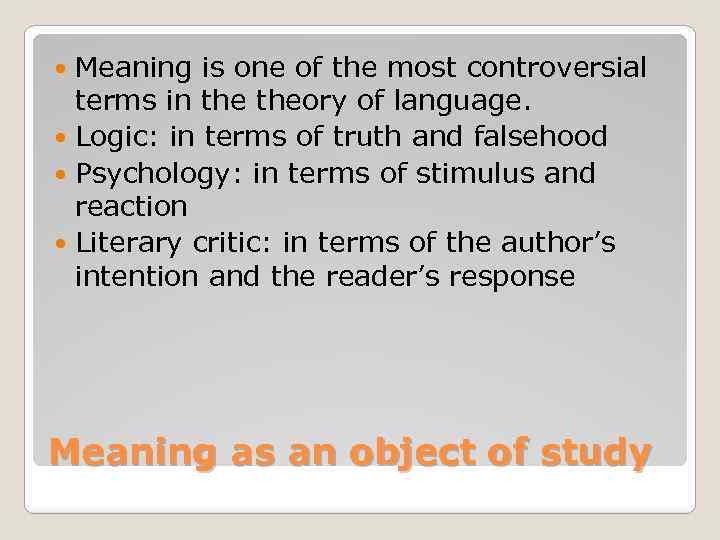 Meaning is one of the most controversial terms in theory of language. Logic: in terms of truth and falsehood Psychology: in terms of stimulus and reaction Literary critic: in terms of the author’s intention and the reader’s response Meaning as an object of study
Meaning is one of the most controversial terms in theory of language. Logic: in terms of truth and falsehood Psychology: in terms of stimulus and reaction Literary critic: in terms of the author’s intention and the reader’s response Meaning as an object of study
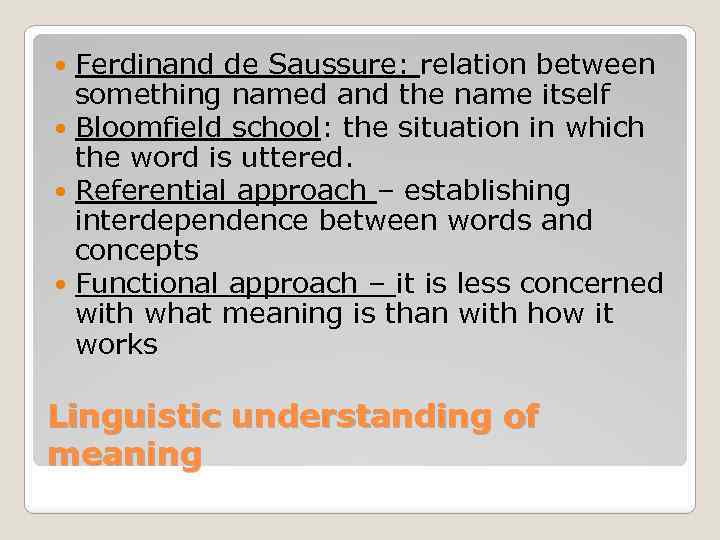 Ferdinand de Saussure: relation between something named and the name itself Bloomfield school: the situation in which the word is uttered. Referential approach – establishing interdependence between words and concepts Functional approach – it is less concerned with what meaning is than with how it works Linguistic understanding of meaning
Ferdinand de Saussure: relation between something named and the name itself Bloomfield school: the situation in which the word is uttered. Referential approach – establishing interdependence between words and concepts Functional approach – it is less concerned with what meaning is than with how it works Linguistic understanding of meaning
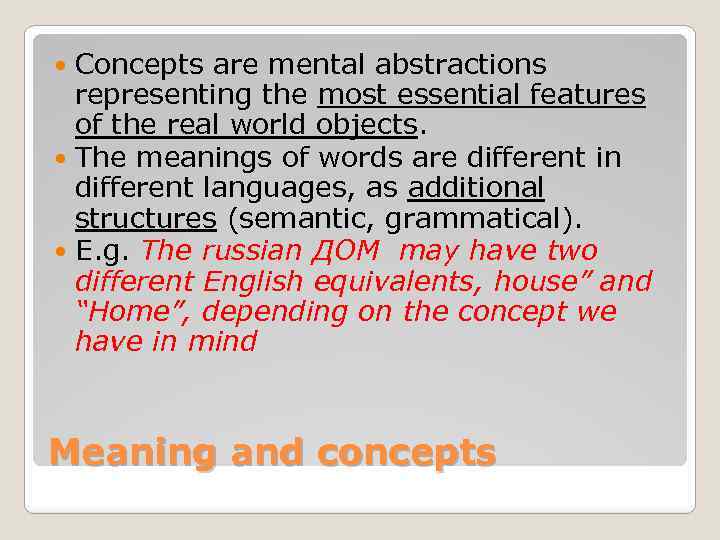 Concepts are mental abstractions representing the most essential features of the real world objects. The meanings of words are different in different languages, as additional structures (semantic, grammatical). E. g. The russian ДОМ may have two different English equivalents, house” and “Home”, depending on the concept we have in mind Meaning and concepts
Concepts are mental abstractions representing the most essential features of the real world objects. The meanings of words are different in different languages, as additional structures (semantic, grammatical). E. g. The russian ДОМ may have two different English equivalents, house” and “Home”, depending on the concept we have in mind Meaning and concepts
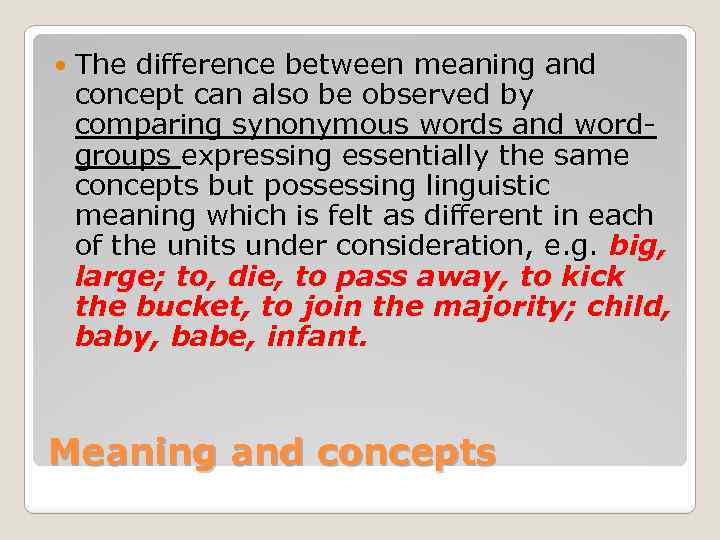 The difference between meaning and concept can also be observed by comparing synonymous words and wordgroups expressing essentially the same concepts but possessing linguistic meaning which is felt as different in each of the units under consideration, e. g. big, large; to, die, to pass away, to kick the bucket, to join the majority; child, baby, babe, infant. Meaning and concepts
The difference between meaning and concept can also be observed by comparing synonymous words and wordgroups expressing essentially the same concepts but possessing linguistic meaning which is felt as different in each of the units under consideration, e. g. big, large; to, die, to pass away, to kick the bucket, to join the majority; child, baby, babe, infant. Meaning and concepts
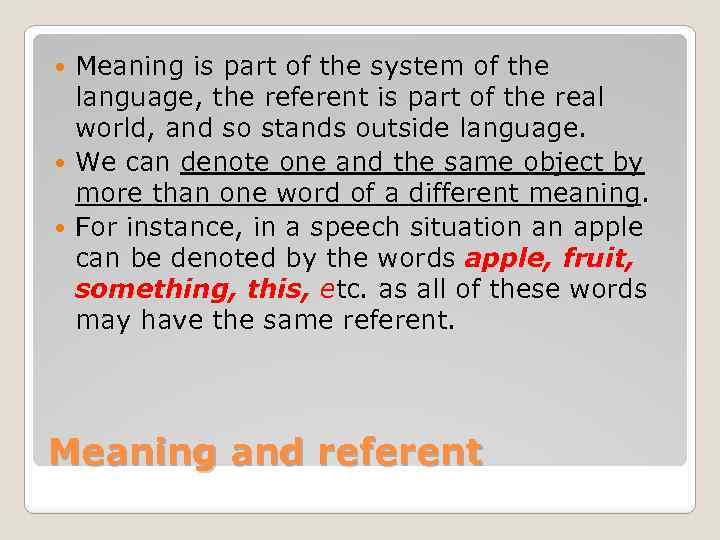 Meaning is part of the system of the language, the referent is part of the real world, and so stands outside language. We can denote one and the same object by more than one word of a different meaning. For instance, in a speech situation an apple can be denoted by the words apple, fruit, something, this, etc. as all of these words may have the same referent. Meaning and referent
Meaning is part of the system of the language, the referent is part of the real world, and so stands outside language. We can denote one and the same object by more than one word of a different meaning. For instance, in a speech situation an apple can be denoted by the words apple, fruit, something, this, etc. as all of these words may have the same referent. Meaning and referent
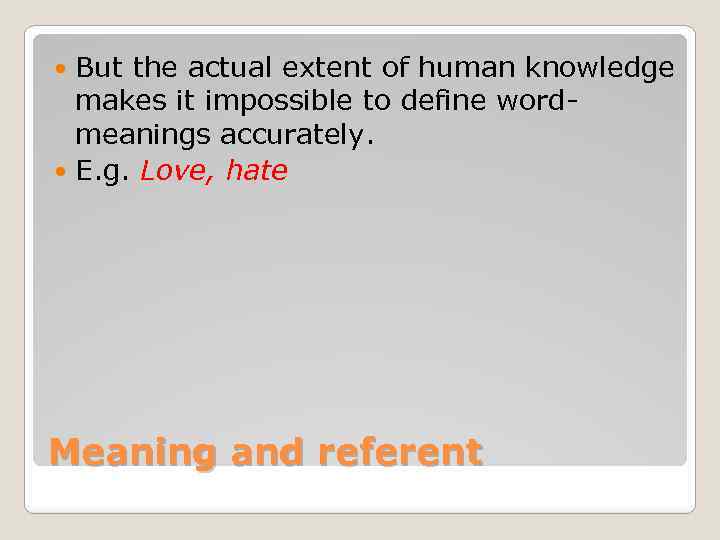 But the actual extent of human knowledge makes it impossible to define wordmeanings accurately. E. g. Love, hate Meaning and referent
But the actual extent of human knowledge makes it impossible to define wordmeanings accurately. E. g. Love, hate Meaning and referent
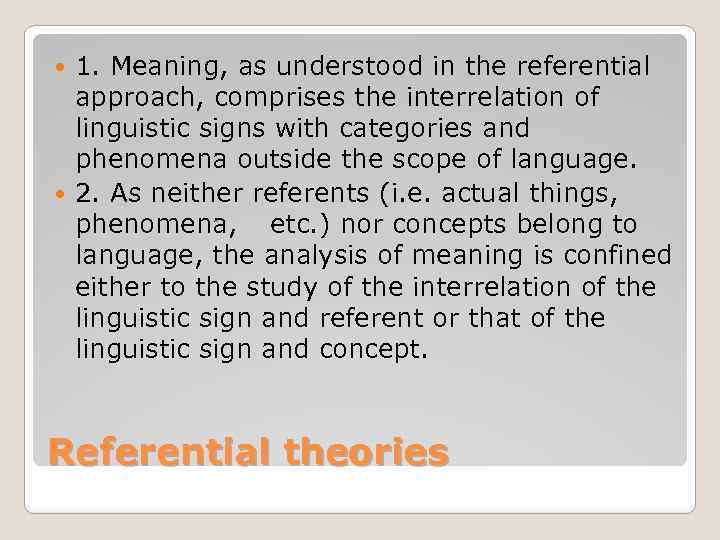 1. Meaning, as understood in the referential approach, comprises the interrelation of linguistic signs with categories and phenomena outside the scope of language. 2. As neither referents (i. e. actual things, phenomena, etc. ) nor concepts belong to language, the analysis of meaning is confined either to the study of the interrelation of the linguistic sign and referent or that of the linguistic sign and concept. Referential theories
1. Meaning, as understood in the referential approach, comprises the interrelation of linguistic signs with categories and phenomena outside the scope of language. 2. As neither referents (i. e. actual things, phenomena, etc. ) nor concepts belong to language, the analysis of meaning is confined either to the study of the interrelation of the linguistic sign and referent or that of the linguistic sign and concept. Referential theories
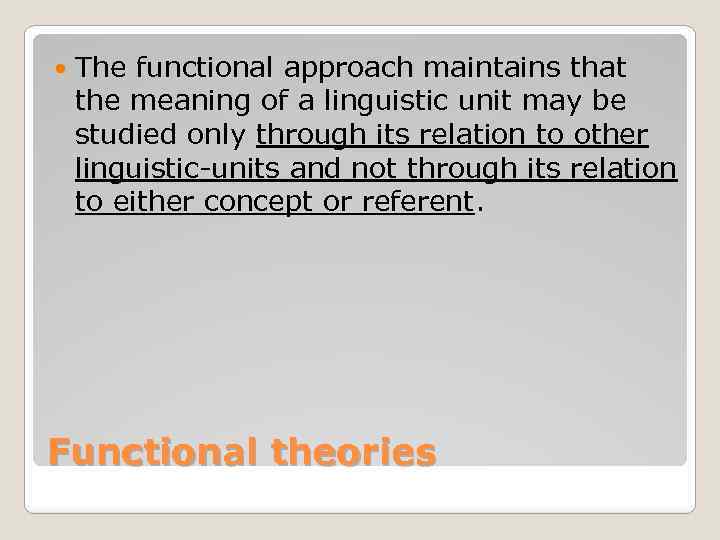 The functional approach maintains that the meaning of a linguistic unit may be studied only through its relation to other linguistic-units and not through its relation to either concept or referent. Functional theories
The functional approach maintains that the meaning of a linguistic unit may be studied only through its relation to other linguistic-units and not through its relation to either concept or referent. Functional theories
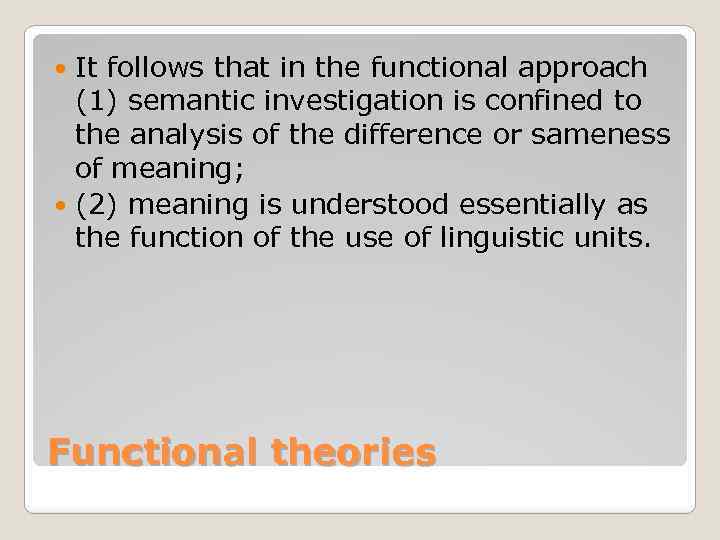 It follows that in the functional approach (1) semantic investigation is confined to the analysis of the difference or sameness of meaning; (2) meaning is understood essentially as the function of the use of linguistic units. Functional theories
It follows that in the functional approach (1) semantic investigation is confined to the analysis of the difference or sameness of meaning; (2) meaning is understood essentially as the function of the use of linguistic units. Functional theories
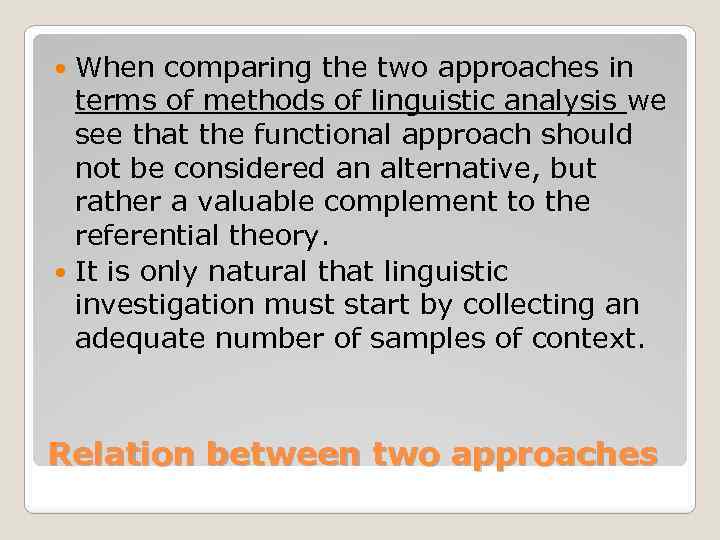 When comparing the two approaches in terms of methods of linguistic analysis we see that the functional approach should not be considered an alternative, but rather a valuable complement to the referential theory. It is only natural that linguistic investigation must start by collecting an adequate number of samples of context. Relation between two approaches
When comparing the two approaches in terms of methods of linguistic analysis we see that the functional approach should not be considered an alternative, but rather a valuable complement to the referential theory. It is only natural that linguistic investigation must start by collecting an adequate number of samples of context. Relation between two approaches
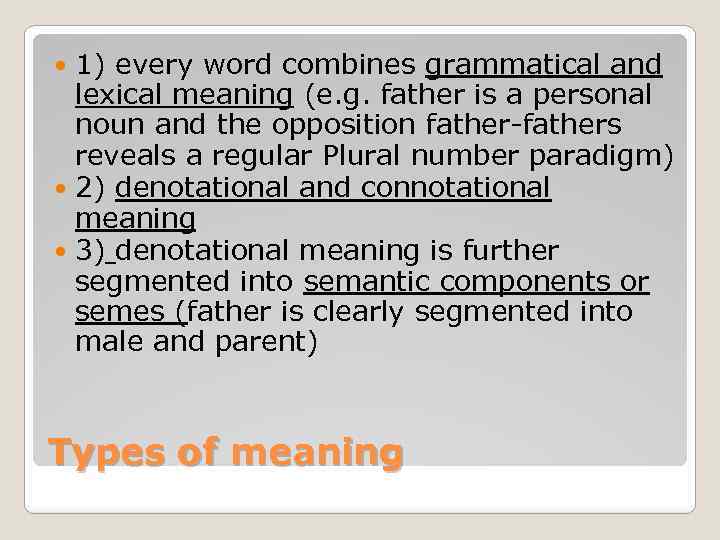 1) every word combines grammatical and lexical meaning (e. g. father is a personal noun and the opposition father-fathers reveals a regular Plural number paradigm) 2) denotational and connotational meaning 3) denotational meaning is further segmented into semantic components or semes (father is clearly segmented into male and parent) Types of meaning
1) every word combines grammatical and lexical meaning (e. g. father is a personal noun and the opposition father-fathers reveals a regular Plural number paradigm) 2) denotational and connotational meaning 3) denotational meaning is further segmented into semantic components or semes (father is clearly segmented into male and parent) Types of meaning
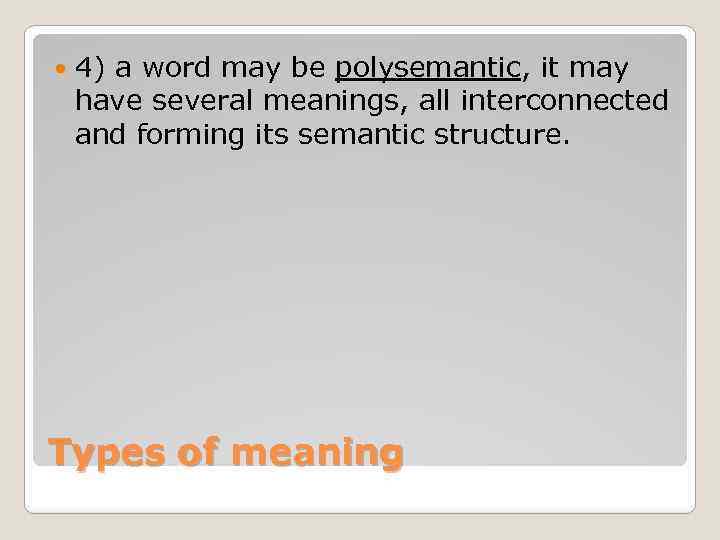 4) a word may be polysemantic, it may have several meanings, all interconnected and forming its semantic structure. Types of meaning
4) a word may be polysemantic, it may have several meanings, all interconnected and forming its semantic structure. Types of meaning
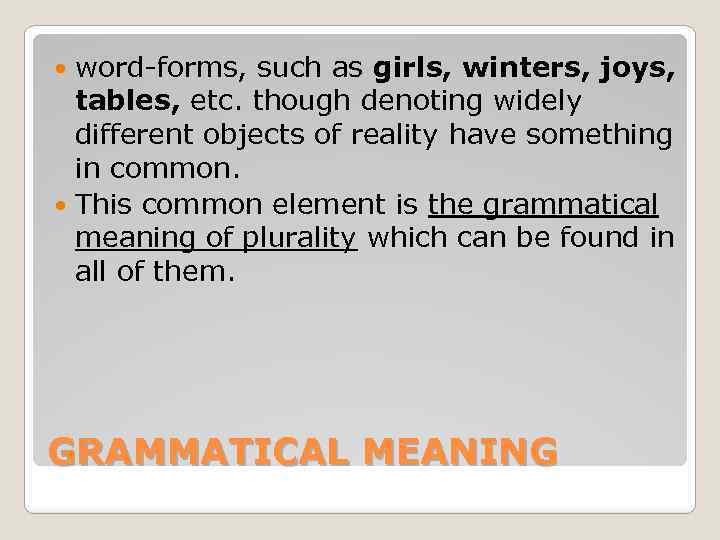 word-forms, such as girls, winters, joys, tables, etc. though denoting widely different objects of reality have something in common. This common element is the grammatical meaning of plurality which can be found in all of them. GRAMMATICAL MEANING
word-forms, such as girls, winters, joys, tables, etc. though denoting widely different objects of reality have something in common. This common element is the grammatical meaning of plurality which can be found in all of them. GRAMMATICAL MEANING
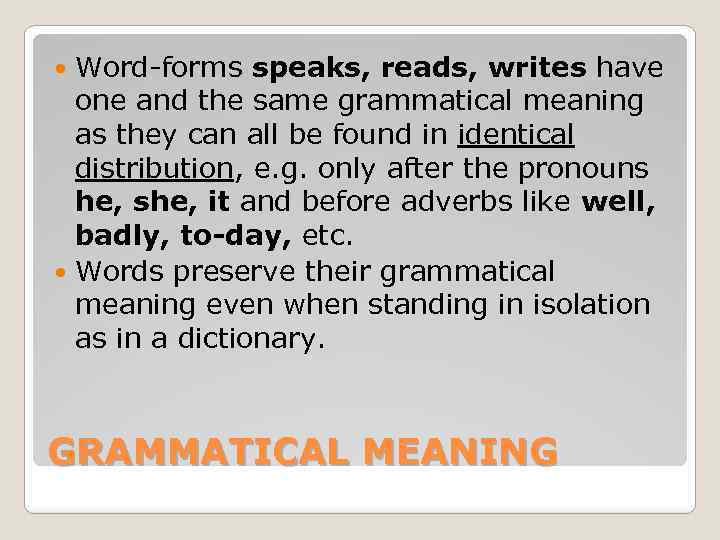 Word-forms speaks, reads, writes have one and the same grammatical meaning as they can all be found in identical distribution, e. g. only after the pronouns he, she, it and before adverbs like well, badly, to-day, etc. Words preserve their grammatical meaning even when standing in isolation as in a dictionary. GRAMMATICAL MEANING
Word-forms speaks, reads, writes have one and the same grammatical meaning as they can all be found in identical distribution, e. g. only after the pronouns he, she, it and before adverbs like well, badly, to-day, etc. Words preserve their grammatical meaning even when standing in isolation as in a dictionary. GRAMMATICAL MEANING
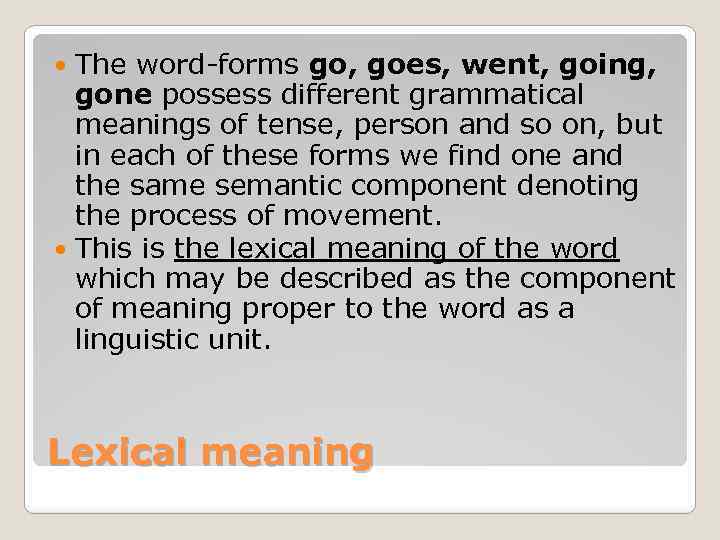 The word-forms go, goes, went, going, gone possess different grammatical meanings of tense, person and so on, but in each of these forms we find one and the same semantic component denoting the process of movement. This is the lexical meaning of the word which may be described as the component of meaning proper to the word as a linguistic unit. Lexical meaning
The word-forms go, goes, went, going, gone possess different grammatical meanings of tense, person and so on, but in each of these forms we find one and the same semantic component denoting the process of movement. This is the lexical meaning of the word which may be described as the component of meaning proper to the word as a linguistic unit. Lexical meaning
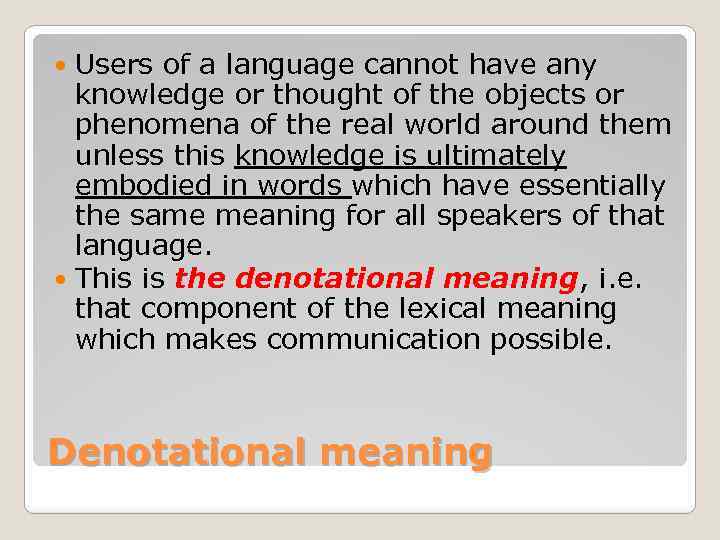 Users of a language cannot have any knowledge or thought of the objects or phenomena of the real world around them unless this knowledge is ultimately embodied in words which have essentially the same meaning for all speakers of that language. This is the denotational meaning, i. e. that component of the lexical meaning which makes communication possible. Denotational meaning
Users of a language cannot have any knowledge or thought of the objects or phenomena of the real world around them unless this knowledge is ultimately embodied in words which have essentially the same meaning for all speakers of that language. This is the denotational meaning, i. e. that component of the lexical meaning which makes communication possible. Denotational meaning
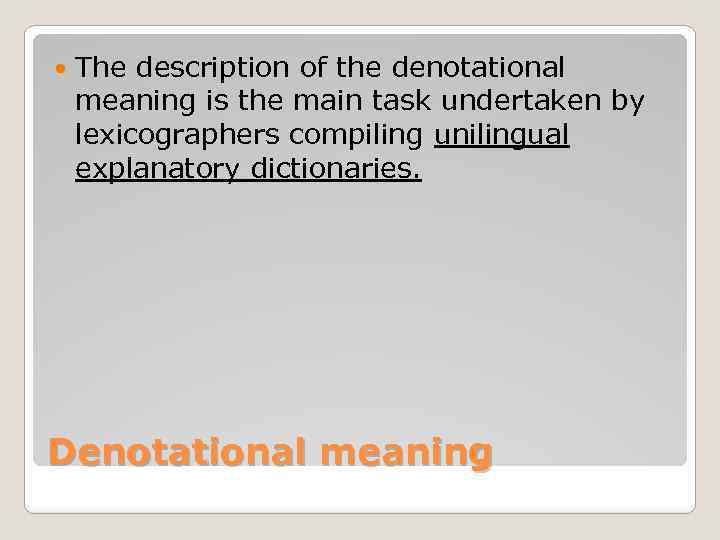 The description of the denotational meaning is the main task undertaken by lexicographers compiling unilingual explanatory dictionaries. Denotational meaning
The description of the denotational meaning is the main task undertaken by lexicographers compiling unilingual explanatory dictionaries. Denotational meaning
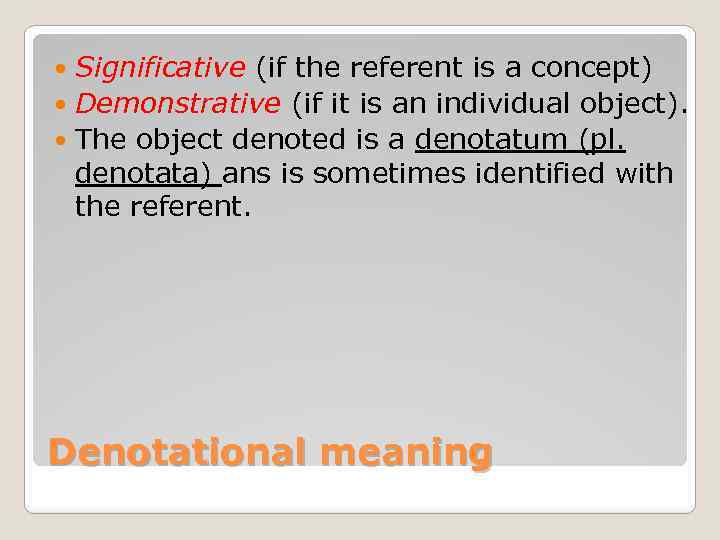 Significative (if the referent is a concept) Demonstrative (if it is an individual object). The object denoted is a denotatum (pl. denotata) ans is sometimes identified with the referent. Denotational meaning
Significative (if the referent is a concept) Demonstrative (if it is an individual object). The object denoted is a denotatum (pl. denotata) ans is sometimes identified with the referent. Denotational meaning
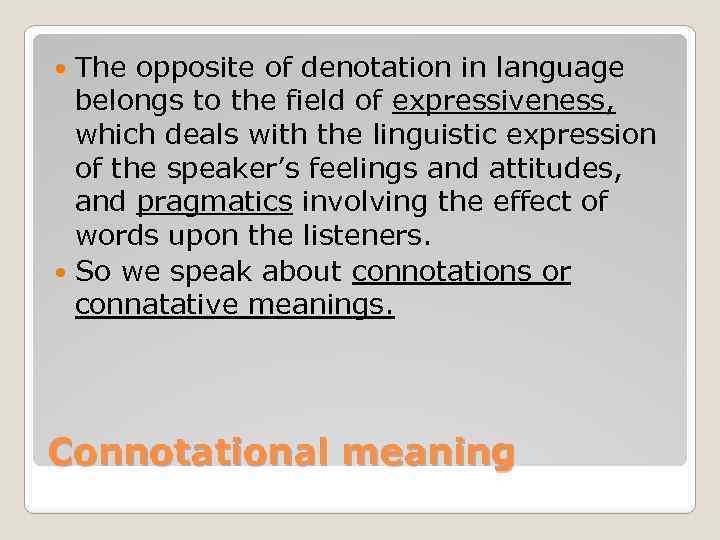 The opposite of denotation in language belongs to the field of expressiveness, which deals with the linguistic expression of the speaker’s feelings and attitudes, and pragmatics involving the effect of words upon the listeners. So we speak about connotations or connatative meanings. Connotational meaning
The opposite of denotation in language belongs to the field of expressiveness, which deals with the linguistic expression of the speaker’s feelings and attitudes, and pragmatics involving the effect of words upon the listeners. So we speak about connotations or connatative meanings. Connotational meaning
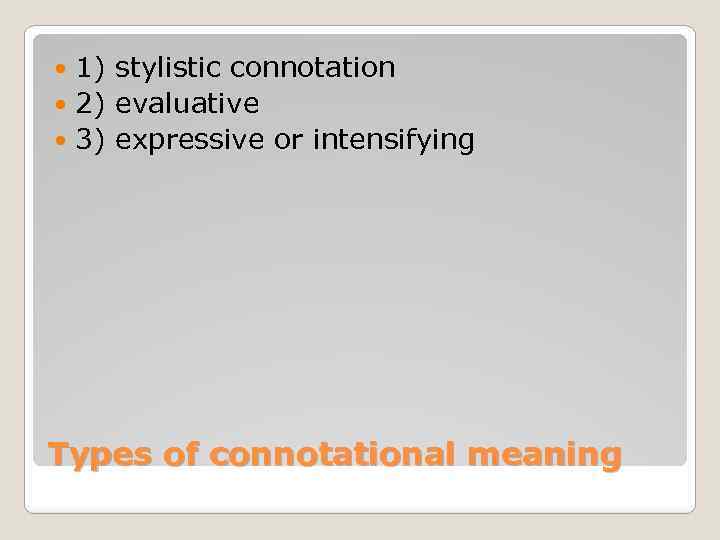 1) stylistic connotation 2) evaluative 3) expressive or intensifying Types of connotational meaning
1) stylistic connotation 2) evaluative 3) expressive or intensifying Types of connotational meaning
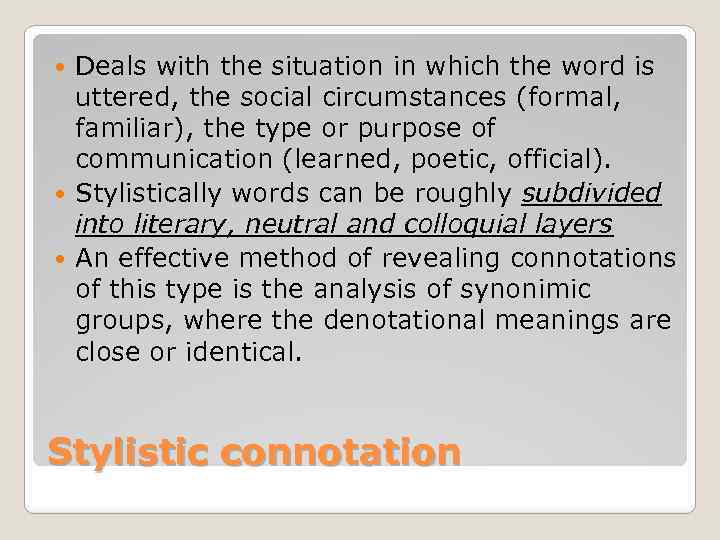 Deals with the situation in which the word is uttered, the social circumstances (formal, familiar), the type or purpose of communication (learned, poetic, official). Stylistically words can be roughly subdivided into literary, neutral and colloquial layers An effective method of revealing connotations of this type is the analysis of synonimic groups, where the denotational meanings are close or identical. Stylistic connotation
Deals with the situation in which the word is uttered, the social circumstances (formal, familiar), the type or purpose of communication (learned, poetic, official). Stylistically words can be roughly subdivided into literary, neutral and colloquial layers An effective method of revealing connotations of this type is the analysis of synonimic groups, where the denotational meanings are close or identical. Stylistic connotation
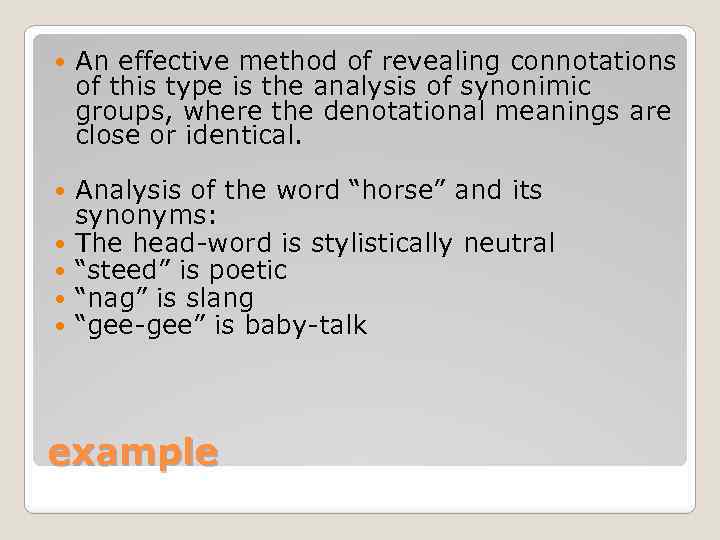 An effective method of revealing connotations of this type is the analysis of synonimic groups, where the denotational meanings are close or identical. Analysis of the word “horse” and its synonyms: The head-word is stylistically neutral “steed” is poetic “nag” is slang “gee-gee” is baby-talk example
An effective method of revealing connotations of this type is the analysis of synonimic groups, where the denotational meanings are close or identical. Analysis of the word “horse” and its synonyms: The head-word is stylistically neutral “steed” is poetic “nag” is slang “gee-gee” is baby-talk example
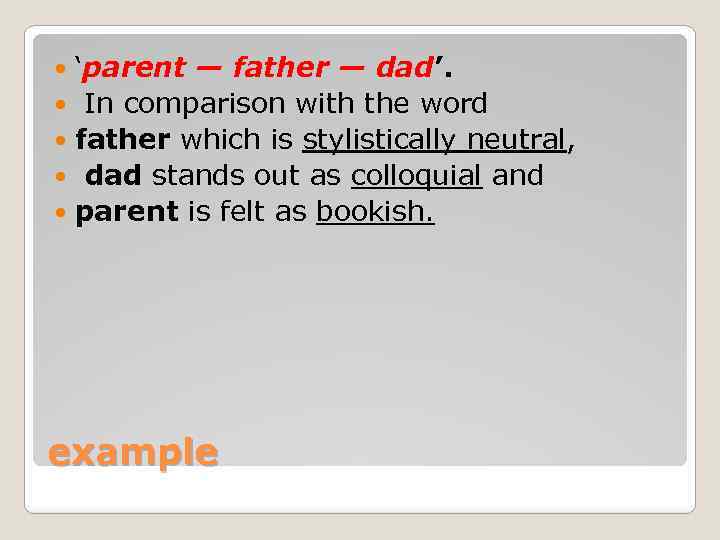 ‘parent — father — dad’. In comparison with the word father which is stylistically neutral, dad stands out as colloquial and parent is felt as bookish. example
‘parent — father — dad’. In comparison with the word father which is stylistically neutral, dad stands out as colloquial and parent is felt as bookish. example
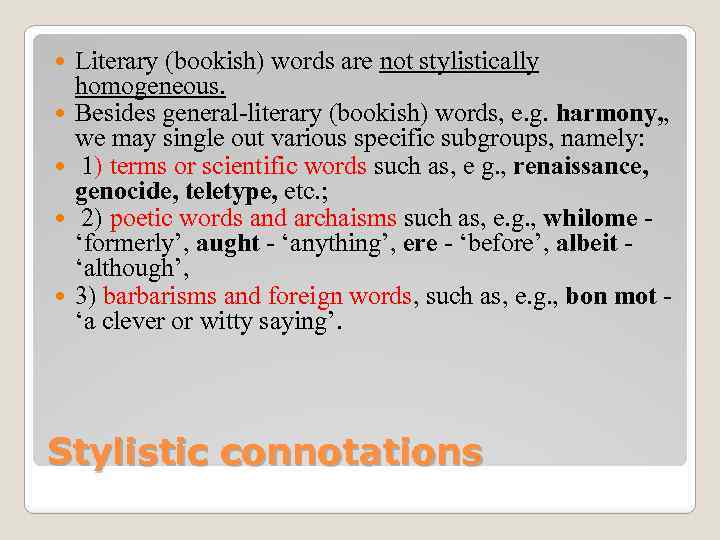 Literary (bookish) words are not stylistically homogeneous. Besides general-literary (bookish) words, e. g. harmony, , we may single out various specific subgroups, namely: 1) terms or scientific words such as, e g. , renaissance, genocide, teletype, etc. ; 2) poetic words and archaisms such as, e. g. , whilome ‘formerly’, aught - ‘anything’, ere - ‘before’, albeit ‘although’, 3) barbarisms and foreign words, such as, e. g. , bon mot ‘a clever or witty saying’. Stylistic connotations
Literary (bookish) words are not stylistically homogeneous. Besides general-literary (bookish) words, e. g. harmony, , we may single out various specific subgroups, namely: 1) terms or scientific words such as, e g. , renaissance, genocide, teletype, etc. ; 2) poetic words and archaisms such as, e. g. , whilome ‘formerly’, aught - ‘anything’, ere - ‘before’, albeit ‘although’, 3) barbarisms and foreign words, such as, e. g. , bon mot ‘a clever or witty saying’. Stylistic connotations
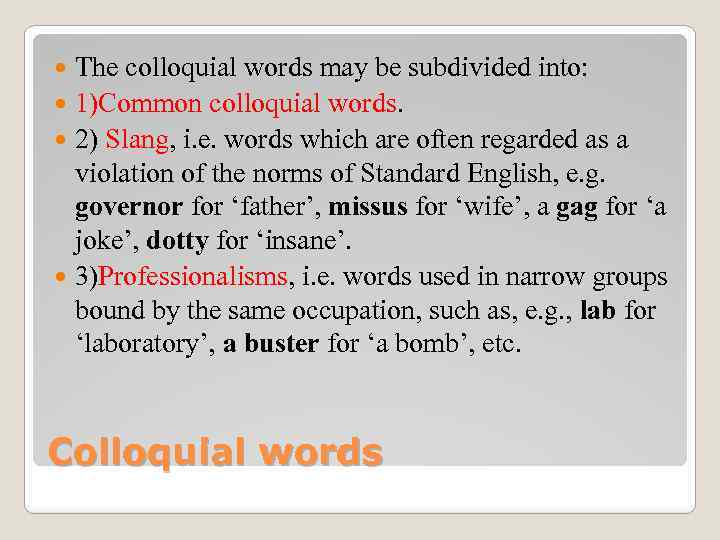 The colloquial words may be subdivided into: 1)Common colloquial words. 2) Slang, i. e. words which are often regarded as a violation of the norms of Standard English, e. g. governor for ‘father’, missus for ‘wife’, a gag for ‘a joke’, dotty for ‘insane’. 3)Professionalisms, i. e. words used in narrow groups bound by the same occupation, such as, e. g. , lab for ‘laboratory’, a buster for ‘a bomb’, etc. Colloquial words
The colloquial words may be subdivided into: 1)Common colloquial words. 2) Slang, i. e. words which are often regarded as a violation of the norms of Standard English, e. g. governor for ‘father’, missus for ‘wife’, a gag for ‘a joke’, dotty for ‘insane’. 3)Professionalisms, i. e. words used in narrow groups bound by the same occupation, such as, e. g. , lab for ‘laboratory’, a buster for ‘a bomb’, etc. Colloquial words
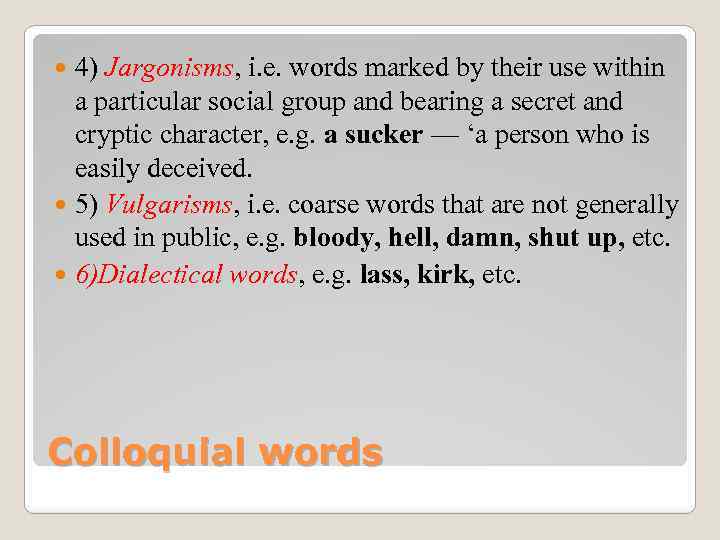 4) Jargonisms, i. e. words marked by their use within a particular social group and bearing a secret and cryptic character, e. g. a sucker — ‘a person who is easily deceived. 5) Vulgarisms, i. e. coarse words that are not generally used in public, e. g. bloody, hell, damn, shut up, etc. 6)Dialectical words, e. g. lass, kirk, etc. Colloquial words
4) Jargonisms, i. e. words marked by their use within a particular social group and bearing a secret and cryptic character, e. g. a sucker — ‘a person who is easily deceived. 5) Vulgarisms, i. e. coarse words that are not generally used in public, e. g. bloody, hell, damn, shut up, etc. 6)Dialectical words, e. g. lass, kirk, etc. Colloquial words
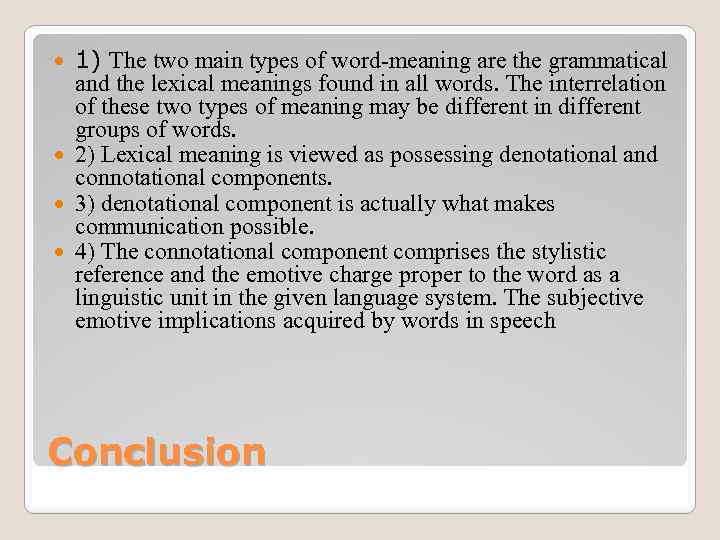 1) The two main types of word-meaning are the grammatical and the lexical meanings found in all words. The interrelation of these two types of meaning may be different in different groups of words. 2) Lexical meaning is viewed as possessing denotational and connotational components. 3) denotational component is actually what makes communication possible. 4) The connotational component comprises the stylistic reference and the emotive charge proper to the word as a linguistic unit in the given language system. The subjective emotive implications acquired by words in speech Conclusion
1) The two main types of word-meaning are the grammatical and the lexical meanings found in all words. The interrelation of these two types of meaning may be different in different groups of words. 2) Lexical meaning is viewed as possessing denotational and connotational components. 3) denotational component is actually what makes communication possible. 4) The connotational component comprises the stylistic reference and the emotive charge proper to the word as a linguistic unit in the given language system. The subjective emotive implications acquired by words in speech Conclusion
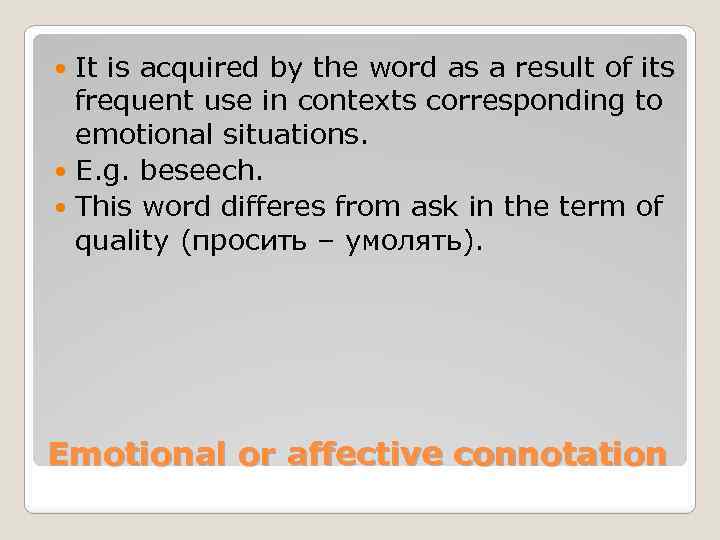 It is acquired by the word as a result of its frequent use in contexts corresponding to emotional situations. E. g. beseech. This word differes from ask in the term of quality (просить – умолять). Emotional or affective connotation
It is acquired by the word as a result of its frequent use in contexts corresponding to emotional situations. E. g. beseech. This word differes from ask in the term of quality (просить – умолять). Emotional or affective connotation
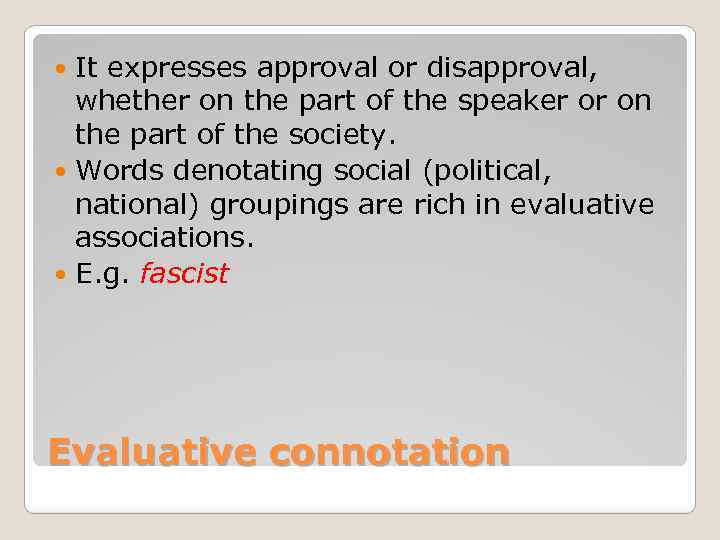 It expresses approval or disapproval, whether on the part of the speaker or on the part of the society. Words denotating social (political, national) groupings are rich in evaluative associations. E. g. fascist Evaluative connotation
It expresses approval or disapproval, whether on the part of the speaker or on the part of the society. Words denotating social (political, national) groupings are rich in evaluative associations. E. g. fascist Evaluative connotation
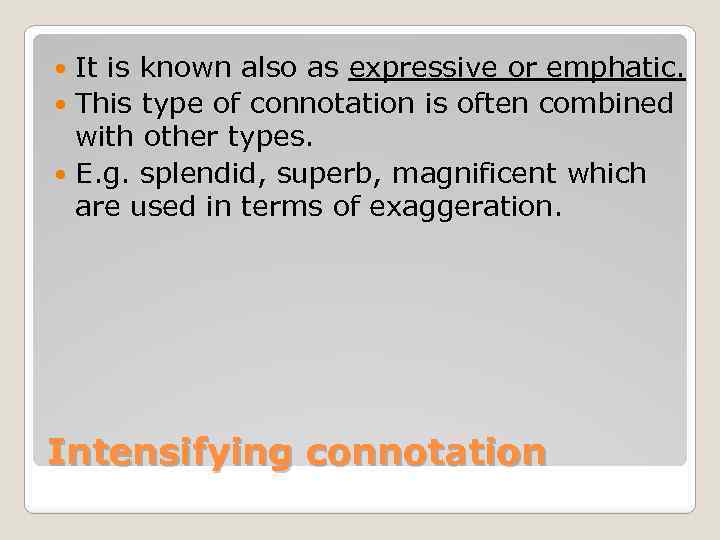 It is known also as expressive or emphatic. This type of connotation is often combined with other types. E. g. splendid, superb, magnificent which are used in terms of exaggeration. Intensifying connotation
It is known also as expressive or emphatic. This type of connotation is often combined with other types. E. g. splendid, superb, magnificent which are used in terms of exaggeration. Intensifying connotation
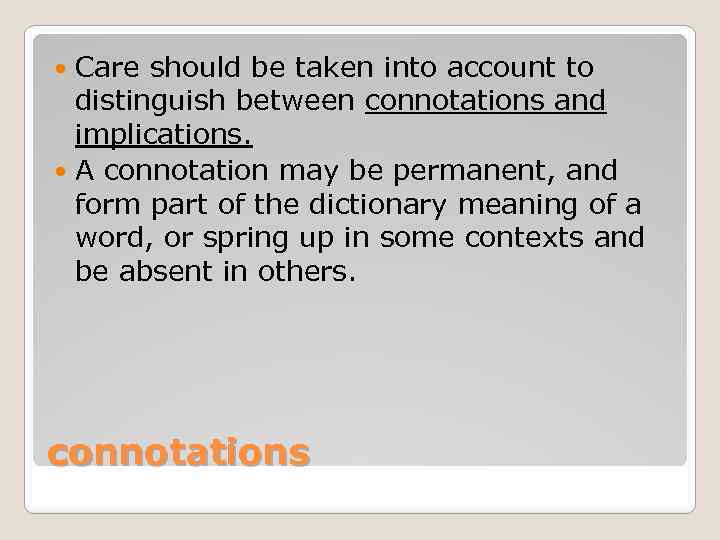 Care should be taken into account to distinguish between connotations and implications. A connotation may be permanent, and form part of the dictionary meaning of a word, or spring up in some contexts and be absent in others. connotations
Care should be taken into account to distinguish between connotations and implications. A connotation may be permanent, and form part of the dictionary meaning of a word, or spring up in some contexts and be absent in others. connotations
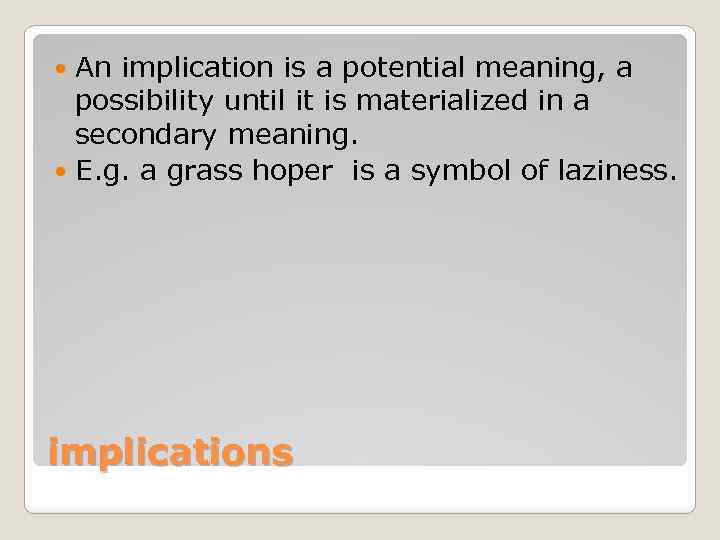 An implication is a potential meaning, a possibility until it is materialized in a secondary meaning. E. g. a grass hoper is a symbol of laziness. implications
An implication is a potential meaning, a possibility until it is materialized in a secondary meaning. E. g. a grass hoper is a symbol of laziness. implications
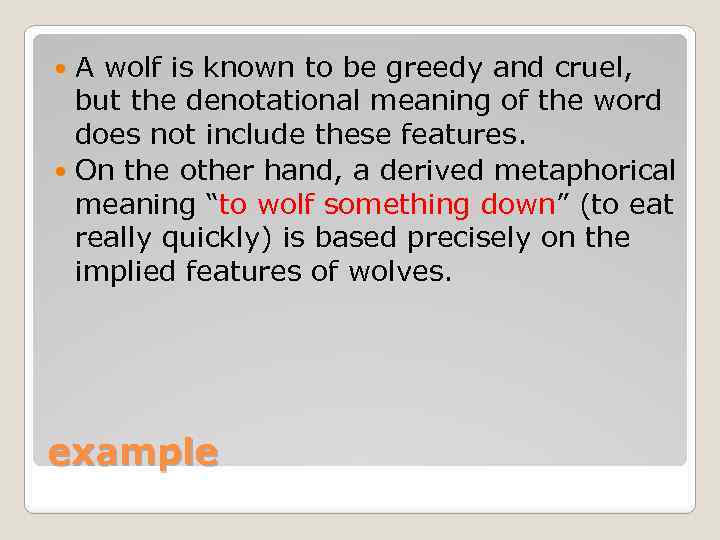 A wolf is known to be greedy and cruel, but the denotational meaning of the word does not include these features. On the other hand, a derived metaphorical meaning “to wolf something down” (to eat really quickly) is based precisely on the implied features of wolves. example
A wolf is known to be greedy and cruel, but the denotational meaning of the word does not include these features. On the other hand, a derived metaphorical meaning “to wolf something down” (to eat really quickly) is based precisely on the implied features of wolves. example
